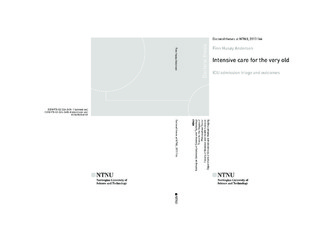| dc.contributor.advisor | Kvåle, Reidar | |
| dc.contributor.advisor | Flaatten, Hans | |
| dc.contributor.advisor | Klepstad, Pål | |
| dc.contributor.author | Andersen, Finn Husøy | |
| dc.date.accessioned | 2017-07-04T07:24:53Z | |
| dc.date.available | 2017-07-04T07:24:53Z | |
| dc.date.issued | 2017 | |
| dc.identifier.isbn | 978-82-326-2405-8 | |
| dc.identifier.issn | 1503-8181 | |
| dc.identifier.uri | http://hdl.handle.net/11250/2447675 | |
| dc.description.abstract | Introduction: The older population is expected to increase markedly during the next decades. The life expectancy of older patients is increasing, but the prevalence of conditions that require ICU treatment is also growing. Currently, patients aged 80 years or older comprise about 10-15% of the patients admitted to ICUs, and this proportion is forecasted to increase in the future. However, ICU resources are not expected to expand in parallel with the potential increase in octogenarian patients that require ICU admission. Consequently, excessive demand could lead to a change in ICU admission policy, with lower priority given to older individuals. Hence, to identify very old patients that are likely to benefit from ICU treatment, it is important to elucidate the decision-making process of triage for ICU admission; to document short- and long-term outcomes of very old patients treated in the ICU; and to identify prognostic factors in very old ICU patients.
Methods: In study I, we evaluated the ICU admission triage decisions performed at six Norwegian hospitals over a one-year period. We analyzed risk factors for ICU refusal, reported the long-term survival, investigated predictors of mortality in hospital survivors, and performed a follow-up longer than one year after ICU triage, with assessments of health-related quality of life (HRQOL), functional status, and residential status. Study II was a retrospective ICU cohort study that analyzed short-term outcomes in octogenarian patients compared to patients between 50 and 80 years of age. Data were collected from the Norwegian intensive care registry (NIR) over a period of four years (2006-2009). Additionally, we performed a subgroup analysis of 5-year age groups. Study III retrospectively analyzed survival of patients ≥80 years old after ICU treatment. Patients were admitted to the Haukeland University Hospital during the time period of 2000–2012. HRQOL was prospectively analyzed in survivors at follow-up, and the assessments were compared to assessments of a portion of the general population matched for age and gender.
Results: Norwegian ICU physicians refused ICU admission to three out of 10 octogenarians; age and functional status were the risk factors for refusal in patients considered too ill/old. Compared to younger patients, patients aged 80 years or older had a lower short-term overall survival after ICU treatment; they showed a trend of dying in the ward, rather than in the ICU; they had shorter ICU stays; and they received less mechanical ventilator support. Adjusted long-term survival of ICU admission triage patients was significantly lower in patients considered too ill/old than in ICU admitted patients. Furthermore, analyses showed that long-term survival rates among patients that survived the first year after ICU admittance were similar to long-term survival rates of octogenarian individuals in the general Norwegian population. The HRQOL of long-term survivors was comparable to (paper III) or worse than (paper I) the HRQOL of an age- and sex-matched general population group.
Conclusions: Norwegian ICU physicians refused ICU admission to 3 out of 10 octogenarians. The higher survival of octogenarians admitted to the ICU compared to patients considered too ill/old could indicate a survival benefit of ICU admission for octogenarians. In particular, patients admitted to ICUs after planned surgery showed satisfactory short- and long-term outcomes. However, once in the ICU, patients aged 80 years or older received less treatment compared to younger patients. Despite the low one-year survival rate, patients that survived the first year after ICU admittance showed long-term survival rates similar to octogenarian individuals in the general Norwegian population. Of our studies that assessed HRQOL in ICU survivors, one showed HRQOL comparable to a control population, but another showed lower HRQOL compared to the same control population. | nb_NO |
| dc.language.iso | eng | nb_NO |
| dc.publisher | NTNU | nb_NO |
| dc.relation.ispartofseries | Doctoral theses at NTNU;2017:166 | |
| dc.relation.haspart | Paper 1: Andersen, Finn H; Flaatten, Hans; Klepstad, Pål; Follestad, Turid; Strand, Kristian; Krüger, Andreas; Hahn, Michael; Buskop, Christian; Rime, Anne-Karin; Kvåle, Reidar. Long-Term Outcomes After ICU Admission Triage in Octogenarians. Critical Care Medicine.
Is not included due to copyright available at
http;//dx.doi.org/10.1097/CCM.0000000000002098 | nb_NO |
| dc.relation.haspart | Paper 2: Andersen, Finn H; Kvåle, Reidar. Do elderly intensive care unit patients receive less intensive care treatment and have higher mortality?. Acta Anaesthesiologica Scandinavica 2012 ;Volum 56.(10) s. 1298-1305
Is not included due to copyright available at
http://dx.doi.org/10.1111/j.1399-6576.2012.02782.x | nb_NO |
| dc.relation.haspart | Paper 3: Andersen, Finn H; Flaatten, Hans; Klepstad, Pål; Romild, Ulla Kristina; Kvåle, Reidar. Long-term survival and quality of life after intensive care for patients 80 years of age or older. Annals of Intensive Care 2015 ;Volum 5:13
http://dx.doi.org/10.1186/s13613-015-0053-0
Attribution 4.0 International (CC BY 4.0) | nb_NO |
| dc.title | Intensive care for the very old | nb_NO |
| dc.type | Doctoral thesis | nb_NO |

